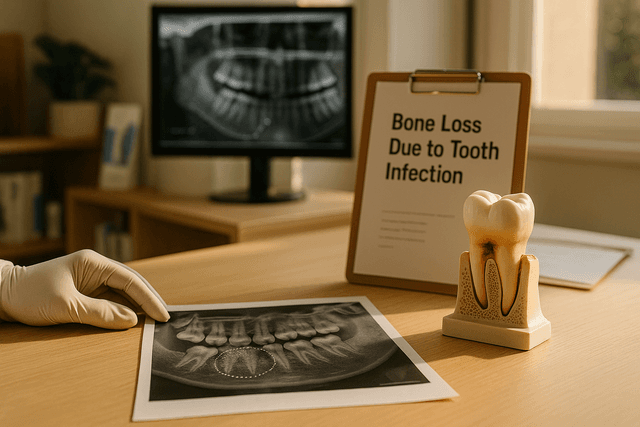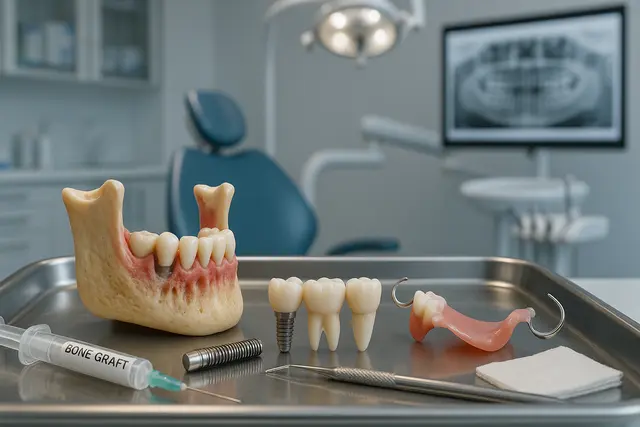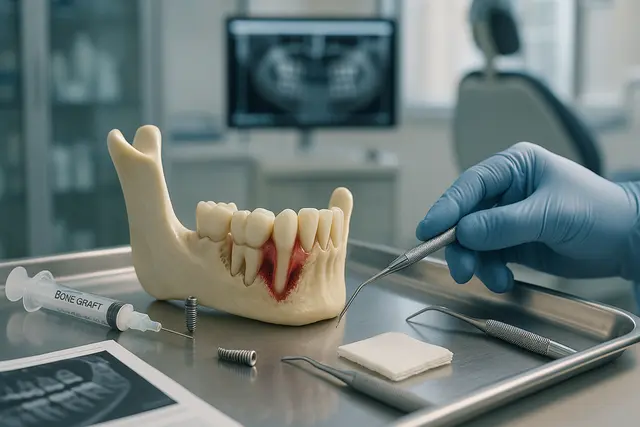Oral Health
5 min read
Sep 25, 2025
Bone Loss Due to Tooth Infection Explained: What It Means for Your Oral Health
A tooth infection isn’t just about pain, it can quietly damage the tissues around a tooth and even erode the jawbone that supports your smile. This guide explains how infections start, why they can lead to bone loss, the warning signs to watch for, and the treatments that can stop the spread and rebuild lost support.

When most people think about a tooth problem, they picture tooth pain, a cavity, or maybe a chipped tooth. What many don’t realize is that a tooth infection can go much deeper, quietly causing damage that affects more than the tooth itself. Left untreated, an infected tooth can spread bacteria to surrounding tissues, erode the bone in that area, and eventually cause bone loss in the jaw. That’s not just a dental issue. It’s something that impacts your oral and overall health.
What Happens When Your Tooth Becomes Infected
A tooth is not just a hard chunk of enamel sitting in your mouth. Inside the tooth is the dental pulp, a soft center that contains nerves and blood vessels. This pulp keeps your natural tooth alive and sensitive. But when bacteria sneak in through a cavity or crack, the pulp can get infected. That’s when the tooth becomes more than just sore. It can be a source of swelling, pressure, and even serious damage to the jawbone if the infection is left untreated.
If an untreated tooth sits too long, infection can spread beyond the pulp into surrounding tissues, including gum tissue around the teeth. This can cause tooth loss, pain that throbs day and night, and eventually, bone tissue damage.
Tooth Infection and Why It Matters for Your Jawbone
When a tooth infection starts, bacteria travel down the tooth root. They can canal and infect the pulp, causing inflammation and killing the soft tissue inside. Without treatment, the infection will spread through the root tip into the jawbone, creating an abscess that destroys bone tissue.
That bone loss in the jaw makes it harder to support a treated tooth, a dental implant, or even neighboring teeth. In other words, one untreated tooth may snowball into multiple dental issues. Infection can spread, lead to bone loss, and create space in the jaw where bone used to be.
Dental Problems That Lead to Bone Loss
Dental issues like cavities, gum disease, and untreated tooth infections are some of the most common reasons people experience bone loss in the jaw. Here’s how it happens:
Tooth decay eats away at enamel and dentin until bacteria reach the pulp inside the tooth.
Gum disease weakens gum tissue around the teeth and can cause bone in that area to break down.
Untreated infections cause abscesses that destroy bone tissue and surrounding tissues.
These conditions don’t just cause tooth pain. They lead to bone tissue loss that compromises your dental health and makes simple tasks like chewing more difficult.
How an Infected Tooth Affects Surrounding Tissues
An infected tooth doesn’t just stay put. Infection can spread into the soft tissue of the gum, the jawbone, and even neighboring teeth. Without treatment, one or more teeth caused by bacteria can compromise the stability of the entire area.
Think of it this way: your jawbone is like the foundation of a house. If infection eats away at part of that foundation, the rest of the house is at risk. Similarly, lost bone tissue around one tooth weakens the natural bone holding other teeth in place. That leads to bone loss and makes the entire mouth more vulnerable.
How Root Canal Can Stop Infection
A root canal is one of the most common ways to save an infected tooth. During this treatment, dental professionals remove the infected pulp, clean out the bacteria, and seal the tooth. By stopping the infection at the root tip, a root canal and infect control can prevent further damage to the jawbone and surrounding tissues.
Root canals may sound intimidating, but they’re often the best way to save a natural tooth and prevent further bone loss in the jaw. Think of it as rebooting your tooth instead of replacing it.
What Bone Graft Means for Lost Bone Tissue
If bone loss in the jaw has already happened, a bone graft may be needed. A graft uses natural bone, synthetic material, or donated bone fragment to fill space in the jaw and encourage bone regeneration. This keeps your teeth strong and creates a stable base for a dental implant if one is needed later.
A bone graft may sound high-tech, but it’s a common procedure that helps prevent further bone loss and restore existing bone. With regeneration, lost bone tissue can heal enough to support a treated tooth or an implant. It’s one of the main ways dentists can rebuild bone in that area and keep your oral health stable.
Symptoms and Causes You Should Watch For
The symptoms and causes of a tooth infection that leads to bone loss are often easy to miss at first. Signs of infection include:
Persistent tooth pain or sensitivity
Swelling in gum tissue around the teeth
Bad taste or pus near the infected tooth
Causes often include plaque buildup, untreated cavities, and periodontal disease. Without treatment, infection can spread, leading to missing tooth problems, tooth extraction, or bone loss in the jaw.
How to Prevent Future Problems
A treated tooth, whether through a root canal, graft, or implant, can be stable and long-lasting if you take care of it. Brushing twice a day and flossing, along with regular dental check-ups and cleanings, keeps bacteria at bay and prevents new infection.
Your dentist may also recommend prompt treatment for any new dental issues, since an infection starts small but infection can spread quickly. Think of prevention as cheaper and easier insurance for your teeth.
Prompt Treatment Saves Oral and Overall Health
Prompt treatment is key. Without treatment, infection will spread, cause tooth loss, and erode the bone. With treatment options like root canal therapy, bone grafting, or a dental implant, your oral and overall health can be preserved.
Even if you already have a missing tooth, modern solution for missing teeth, like implants, can restore both your smile and function. A dental implant is a strong solution for missing teeth because it fuses with existing bone, replacing the natural tooth root and preventing further bone loss.
Practical Tips That Keep Your Teeth Strong
Here’s what you can do every day to prevent infection and bone loss:
Brush your teeth twice a day and flossing to remove plaque.
Schedule cleanings with your dentist regularly.
Watch for signs of infection like pain, swelling, or bleeding gums.
Treat cavities promptly before bacteria infect the pulp inside the tooth.
If you notice symptoms, see your dentist as soon as possible.
These simple habits keep your teeth strong, prevent further bone loss, and make sure your smile lasts a lifetime.
What Causes Bone Loss From a Tooth Infection?
Bone loss begins when bacteria from an infected tooth spread beyond the pulp and into the jawbone. As the infection progresses, it creates inflammation that breaks down bone tissue around the root of the tooth. If left untreated, this can erode the bone that supports both the infected and neighboring teeth, leading to further dental complications and potential tooth loss.
How Can a Root Canal Help Prevent Jawbone Damage?
A root canal removes the infected pulp from inside the tooth, stopping the infection before it reaches the surrounding bone. The tooth is then sealed to prevent reinfection. By removing the bacteria early and preserving the tooth structure, a root canal helps maintain the integrity of the jawbone and reduces the risk of needing a bone graft or implant later on.
What Happens If Bone Loss Has Already Occurred?
If bone tissue has already been destroyed due to an infection, a bone graft may be needed. This procedure places natural or synthetic graft material in the affected area to stimulate new bone growth. Over time, the graft integrates with existing bone, restoring strength and structure, and creating a solid foundation for future dental treatments like implants.
What Are the Early Signs of a Tooth Infection That Can Lead to Bone Loss?
Watch for symptoms like persistent tooth pain, swelling around the gums, sensitivity to hot or cold, a bad taste in the mouth, or pus near a tooth. These signs often indicate a deep infection that can spread to the jawbone. Prompt treatment is essential to prevent long-term damage, including bone erosion and the risk of losing the tooth entirely.
Read Next
Related Posts

Oral Health
Tooth Replacement Options to Prevent Bone Loss
Losing a tooth isn’t just about appearance, it can have a lasting impact on your oral health, jawbone strength, and overall quality of life. When teeth go missing, the jawbone begins to shrink, which can change your bite, your facial structure, and even your confidence. Fortunately, modern dentistry offers several effective solutions to replace missing teeth and prevent further bone loss.
4 min read
Sep 26, 2025

Oral Health
Understanding Bone Loss in Teeth: Causes and Treatments That Work
Bone loss in teeth is a silent threat that can compromise your smile, facial structure, and overall oral health. While it often goes unnoticed in the early stages, it can lead to serious consequences if left untreated. Understanding what causes dental bone loss, and how to prevent or manage it, is key to maintaining a strong, healthy foundation for your teeth.
5 min read
Sep 25, 2025

Oral Health
What Is Mewing Trend? Origins, Science, and Results
From TikTok tutorials to teen slang, "mewing" has taken over the internet as the latest beauty and wellness craze. But beyond the social media hype, what exactly is mewing, and can it really transform your face or improve your jawline? This curious trend centers on one simple thing: where you rest your tongue.
4 min read
Sep 08, 2025
Don’t have time to research every dentist around you?
See why 30k+ patients trusted us